INTRODUCTION
The mineral nutrition of crops is of great concern for producers, who currently use diagnostic tools, such as soil and/or tissue analysis that are costly, time-consuming and inhibit quick decision-making. For tissue or photosynthetic pigment analyses, destructive methodologies are used that, although important in the evaluation of the physiological status of plants, are expensive and inaccessible for producers (Amarante et al., 2009). Furthermore, because of the importance of nitrogen as a primary element in tissue formation (Marschner, 2012), methodologies used for its quantification in laboratories are very costly and require the transport of samples and a lot of time, delaying the implementation of corrective measures for deficiencies of this element.
The early detection of the chlorophyll or nitrogen content in plants facilitates decision-making for dealing with element deficiencies, such as nitrogen (N) and magnesium, which is why diagnosis in a timely manner is essential for producers. Traditionally, farmers use visual parameters such as the greenness of the leaves to determine the need for N. However, this indicator is highly subjective, which is why methods that guarantee a rapid and quantitative diagnosis are needed.
The measurement of variables, such as the chlorophyll index, with non-destructive methods is a widely used technique for different species (Castañeda et al., 2018; Mendoza-Tafolla et al., 2019), including the commonly used SPAD total chlorophyll index type meter. This portable device indirectly, with a non-destructive method, evaluates the total chlorophyll index in leaves by means of light transmitted through the leaf, with the wavelengths 650 and 940 nm, providing an excellent approximation of the total chlorophyll content and N nutritional status in various crops (Zotarelli et al., 2003).
Several studies have indicated the existence of a direct relationship between the chlorophyll content and the N content in leaves because this element is needed for the synthesis of the chlorophyll molecule and is linked to the light phase of the photosynthetic process (Taiz and Zeiger, 2010). Studies carried out by Zotarelli et al. (2003) indicated the importance of using indirect methods, such as the SPAD-502® chlorophyll meter (Konica Minolta, Osaka, Japan), for monitoring the availability of N. Ramírez-Builes et al. (2012) proposed the use of portable chlorophyll meters as a tool for the early detection of N deficiencies and yield decreases associated with stress conditions.
The SPAD-502® chlorophyll meter has been used successfully in the quantification of nitrogen content in crops such as vine apples (Callejas et al., 2014; Castañeda et al., 2018), corn (Castillo and Ligarreto, 2016), basil (Fenech-Larios et al., 2009), and tomatoes (Rodríguez et al., 1998; Hurtado et al., 2017), among others, because this method is easy, fast, and non-destructive.
Therefore, the present study aimed to estimate the concentrations of chlorophyll and nitrogen in guava leaves (Psidium guajava L.) in different phenological stages in order to observe their correlation with the non-destructive SPAD method under field conditions.
MATERIALS AND METHODS
This study was carried out on the San Diego farm, village of Aco de Peña Blanca, which is located in the municipality of Vélez-Santander, with longitude and latitude coordinates: 73°39'30'' W and 5°57'49'' N; 1,920 m a.s.l. The study area was 1 ha, which was georeferenced to fully identify the area in terms of its geographical characteristics and the trees it contained. 408 trees in the P. guajava cv. Regional Roja were identified, which were 5 years old, in the productive stage, established with a planting distance of 5 m between plants and 5 m between rows and traditionally managed, of the 408 trees, 44 trees were selected that belonged to the area, where, historically, this crop has shown good growth and development.
For the quantification of the SPAD total chlorophyll index, the a, b and total chlorophyll contents and the nitrogen content in the tissue, three sampling times were established in the 44 selected plants in order to measure these variables at points where the plants see greater absorption of elements such as nitrogen: E2: visible flower buds, H1: fruit set and I1: fruit filling (80% of total formation), selected according to the phenological scale proposed by Salazar et al. (2006) and carried out with general pruning of the evaluated plants.
To determine the total chlorophyll index in the field, 20 leaves were selected from the branches located in the middle third of the plants, which were fully expanded, in order to quantify the index using a SPAD-502® (Konica Minolta, Osaka, Japan), obtaining the average value per sample unit.
The a, b and total chlorophyll contents were estimated in a laboratory with a spectrophotometer, Thermo Scientific™ Genesys™ 10 series, following the methodology proposed by Solarte et al. (2010) . For this, 0.5 cm radius leaf discs were taken from the middle part of the leaves (between the central rib and the margin) until reaching 5 g (6 leaves), which were placed in a mortar with 14 mL of 80% (v/v) acetone previously cooled to -10ºC, macerated for 5 min, vortexed for 2 min in order to ensure complete contact of the plant material with the acetone, and centrifuged for 10 min at 4000 rpm. The supernatant was removed, placed in a 25 mL volumetric balloon, which was covered with aluminum foil, and titrated with previously cooled 80% (v/v) acetone. The entire process was carried out with low illumination. Finally, an absorbance reading was taken for each sample at a 663 nm wavelength for chlorophyll a and 647 nm for chlorophyll b. The analytical blank was 80% acetone (v/v). The chlorophyll a, b and total contents were calculated with the data using the equations proposed by Lichtenthaler (1987) for 80% acetone (v/v) (Equations 1, 2 and 3):
The tissue nitrogen content was determined with the Kjeldahl method using 150 g samples (15 leaves) of plant material, quantifying the SPAD chlorophyll index. The samples were covered with absorbent paper to eliminate moisture and packed in labeled paper bags, which were stored in a polystyrene refrigerator. The analyses were carried out in the ASAYMA laboratory, Palmira-Colombia.
The data obtained for the chlorophyll a, b and total contents (mg g-1 fresh weight) and the nitrogen content in the leaf tissue (%) were correlated with the data obtained from the total chlorophyll index (SPAD) in order to obtain the respective graphs and regression equations. The correlation analyses were done with the statistical software R 3.6.2, free version.
RESULTS AND DISCUSSION
The data analysis showed the linear relationship between the total chlorophyll index (SPAD) and the chlorophyll a, b and total contents obtained with spectrophotometry for the three evaluated stages (E2, H1, I1). According to the results of the Pearson method correlation analysis, a linear association was observed between the SPAD method and the chlorophyll a, b and total tissue contents, with positive and significant correlation coefficients for all stages with values that ranged from 0.91 to 0.97 (Fig. 1).
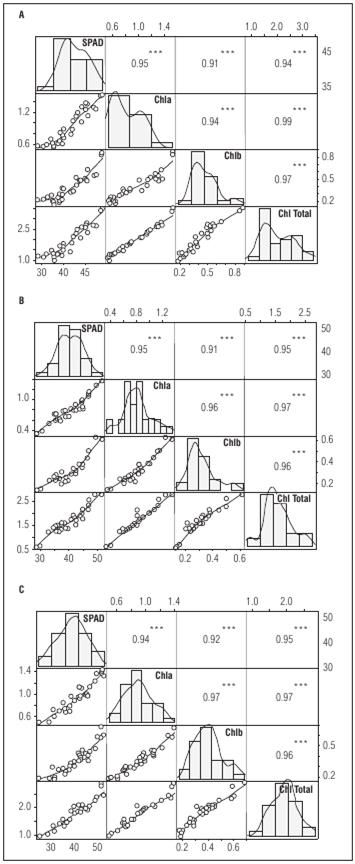
Figure 1 Pearson's method correlation diagram for the total chlorophyll index variables (SPAD) and Chlorophyll a, b and total contents in Psidium guajava L. leaves under the study conditions. A. Stage E2: visible flower buds; B. Stage H1: fruit set; C. Stage I1: fruit filling. *** Significant correlation (P<0.001).
The total chlorophyll index was between 29.0 and 51.9 SPAD units for the evaluated stages, while the total chlorophyll (Chla + Chlb) for stage E2 presented a minimum value of 0.91 and a maximum of 3.45 (Fig. 2); stage H1 presented a minimum value of 0.56 and a maximum of 2.76 (Fig. 3) and stage I1 presented a minimum value of 0.97 and a maximum of 2.86 (Fig. 4).
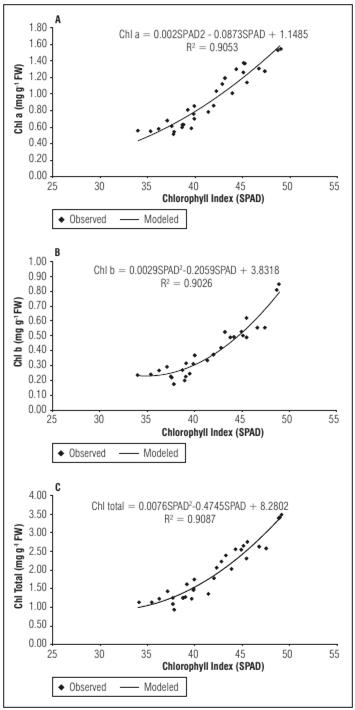
Figure 2 Relationship between the SPAD chlorophyll index and the chlorophyll a (A), b (B) and total (C) contents (mg g-1 fresh weight) in the guava plants (Psidium guajava L.) in stage E2 (visible flower buds).
The above indicated that the quantification of the chlorophyll content, either directly or indirectly, was influenced by the phenological stage. The SPAD method was an important tool for determining the tissue chlorophyll contents, quickly and reliably, in the guava plants under the study conditions and in the evaluated stages.
The results indicated that the SPAD method was highly correlated with the content of photosynthetic pigments, such as chlorophyll a, b and total. According to the polynomial model, an R 2 value greater than or equal to 0.90 (n = 44; P≤0.0001) was obtained in all evaluated stages, indicating that there was a highly significant and positive correlation between the destructive method and the SPAD method (Fig. 2, 3, 4).
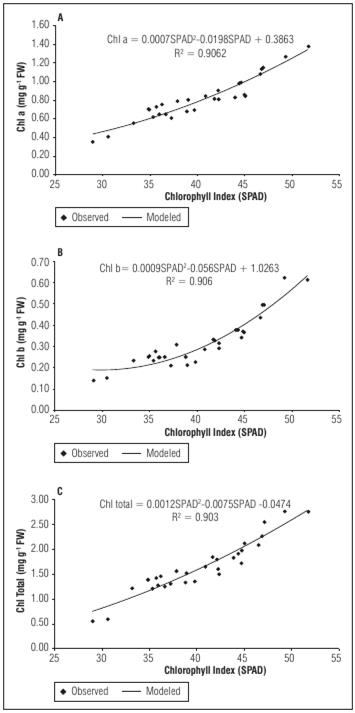
Figure 3 Relationship between SPAD chlorophyll index and chlorophyll a (A), b (B) and total (C) contents (mg g-1 fresh weight) in the guava plants (Psidium guajava L.) in stage H1 (fruit set).
These results agree with those of studies on various species (Zotarelli et al., 2003; Torres Netto et al., 2005; Hurtado et al., 2017). The selection of leaves from the middle third was successful since there was no evidence of high variation in terms of data; similar results were described by Castillo and Ligarreto (2016), who, when evaluating the SPAD method in corn plants, concluded that the best area for sampling is the middle third of the plant.
The results agree with the report by Torres Netto et al. (2005), who indicated that, in coffee leaves, polynomial equations generate the best correlation between the SPAD method and the destructive method. Donnelly et al. (2020) observed that the quadratic model showed the best fit when correlating the SPAD method and the chlorophyll contents extracted from leaves of different tree species. However, the results differed when compared to the behavior of other species with respect to the mathematical adjustment of the studied relationships, such as in tomatoes and cotton, in which the relationships between SPAD readings and the concentrations of photosynthetic pigments were linear (Rodríguez et al., 1998; Neves et al., 2005; Jiang et al., 2017).
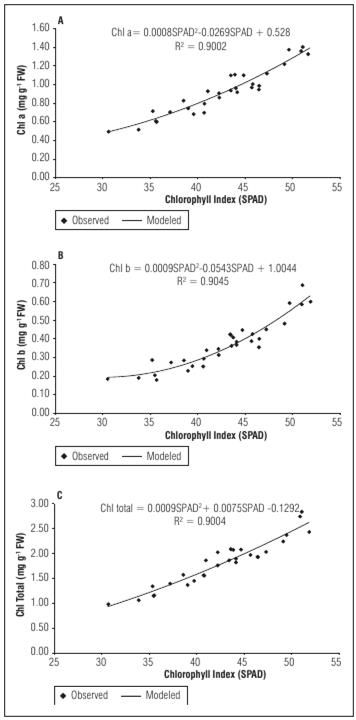
Figure 4 Relationship between the SPAD chlorophyll index and the chlorophyll a, b and total contents (mg g-1 fresh weight) in the guava plants (Psidium guajava L.) in stage I1 (fruit filling).
The results agree with the report by Torres Netto et al. (2005), who indicated that, in coffee leaves, polynomial equations generate the best correlation between the SPAD method and the destructive method. Donnelly et al. (2020) observed that the quadratic model showed the best fit when correlating the SPAD method and the chlorophyll contents extracted from leaves of different tree species. However, the results differed when compared to the behavior of other species with respect to the mathematical adjustment of the studied relationships, such as in tomatoes and cotton, in which the relationships between SPAD readings and the concentrations of photosynthetic pigments were linear (Rodríguez et al., 1998; Neves et al., 2005; Jiang et al., 2017).
Notably, method validation should be carried out for each crop as far as possible under real production conditions (field or greenhouse) because different variations can be generated, including variations in the morphological type, such as an increase or decrease in the leaf thickness, in the physiological type, such as a greater or lesser content of photosynthetic pigments, in the environmental type, such as greater or lesser exposure to light, and in the different genotypes of a species (Jifon et al., 2005; Uddling et al., 2007).
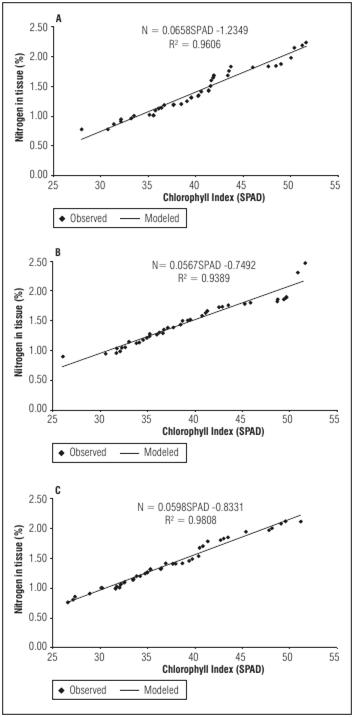
Figure 5 Relationship between the chlorophyll index (SPAD) and the nitrogen content in the leaf tissue (%) of the guava plants (Psidium guajava L.) in different stages A: E2 (visible flower buds); B: H1 (fruit set); C: I1 (fruit filling).
The results for the correlation between the percentage of nitrogen and the SPAD units were similar to those found for the chlorophyll a, b and total contents although it differed in terms of the mathematical model since, in this case, it was adjusted to linear equations. The chlorophyll index values ranged between 34.0 and 51.7 for the SPAD units and 0.7 and 2.46% for the nitrogen content in the leaf tissue (Fig. 5A, B and C).
According to the linear model, coefficient of determination values (R 2) greater than or equal to 0.90 (n = 44; P≤0.0001) were obtained in all evaluated stages (Fig. 5), indicating the existence of a high correlation between the foliar nitrogen content and total chlorophyll index (SPAD). The results agree with the observations of Mendoza-Tafolla et al. (2019), who indicates that readings with a SPAD type meter presented a high correlation (P=0.01) with the foliar nitrogen concentration in L. sativa plants. Which were adjusted to a simple linear regression, with a positive correlation coefficient of 0.95 and a coefficient of determination (R 2) of 0.90. On the other hand, Yue et al. (2020), when performing a correlation analysis of the SPAD method and the nitrogen concentration in wheat plants, indicated adjustment to a second-degree polynomial in different phenological stages and at different times of evaluation.
The nitrogen content in the soil or nutrient solution influenced the SPAD readings and their correlation with the percentage of nitrogen in the leaves. In the present study, the correlation between the methods was positive, connected to the amount of data used and the selection of suitable leaves for the measurement (Figure 5A, B and C). The significance of the correlation depended on the position of the leaf, indicating that, in the middle third, there was high N mobility in the plants since it moves more easily to organs with high transpiration and active photosynthetic processes, as compared to leaves in the upper third, in which said processes are incipient, or leaves in the lower third, in which said processes can be affected by senescence processes (Malavolta et al., 1997). Since the purpose of the SPAD method is to quickly diagnose element deficiencies without visual symptoms, the evaluation of middle-third leaves is more accurate over time (Azia and Stewart, 2001).
CONCLUSION
In the present study, there was a significant correlation between the measurement of the total chlorophyll index (SPAD) and the concentration of chlorophyll a, b and total extractable and the percentage of nitrogen in the foliar tissue, quantified in leaves from the middle third of the guava plants in three phenological stages of the reproductive phase, cultivated under the conditions of the municipality of Vélez-Santander. Linear regression equations were obtained for the nitrogen content in the leaf tissue, and second-degree polynomials were obtained for the chlorophyll a, b and total extractable from the SPAD units.
This study confirmed the usefulness and convenience of using the SPAD technique for the non-destructive determination of chlorophyll and nitrogen contents in foliar tissue in guava plants under field conditions since it is an easy, fast and efficient method; however, the sample used must be representative and sufficient for generating a good correlation.


















